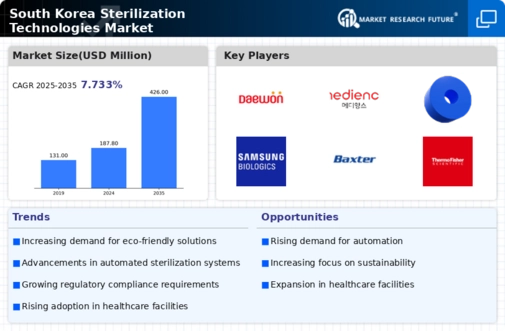Growing Healthcare Infrastructure
The expansion of healthcare facilities in South Korea is a pivotal driver for the sterilization technologies market. With an increasing number of hospitals and clinics, the demand for effective sterilization solutions is on the rise. The healthcare sector's growth is projected to reach a value of approximately $200 billion by 2025, necessitating advanced sterilization technologies to ensure patient safety and compliance with health regulations. This trend indicates a robust market for sterilization technologies, as healthcare providers seek to enhance their infection control measures. Furthermore, the government's investment in healthcare infrastructure is likely to bolster the adoption of innovative sterilization methods, thereby propelling the market forward.
Regulatory Compliance and Standards
Stringent regulatory requirements in South Korea significantly influence the sterilization technologies market. The government mandates compliance with various health and safety standards, compelling healthcare facilities to adopt advanced sterilization methods. For instance, the Ministry of Food and Drug Safety (MFDS) enforces regulations that require hospitals to implement effective sterilization protocols. This regulatory landscape creates a consistent demand for sterilization technologies, as facilities strive to meet compliance and avoid penalties. The market is expected to grow as organizations invest in state-of-the-art sterilization equipment to adhere to these regulations, ensuring patient safety and operational efficiency.
Increased Awareness of Infection Control
The heightened awareness of infection control among healthcare professionals and the general public is a significant driver for the sterilization technologies market. As South Korea continues to prioritize public health, the emphasis on preventing healthcare-associated infections (HAIs) has intensified. This awareness leads to increased investments in sterilization technologies, as hospitals and clinics seek to implement effective infection control measures. The market is projected to grow at a CAGR of around 8% over the next few years, driven by the need for reliable sterilization solutions. This trend suggests that healthcare providers are likely to prioritize advanced sterilization technologies to enhance patient safety and improve overall healthcare outcomes.
Technological Advancements in Sterilization
Innovations in sterilization technologies are transforming the market landscape in South Korea. The introduction of advanced methods such as vaporized hydrogen peroxide and low-temperature plasma sterilization is gaining traction among healthcare providers. These technologies offer enhanced efficacy and reduced environmental impact, aligning with the growing demand for sustainable solutions. The sterilization technologies market is expected to witness substantial growth as these innovations become more widely adopted. Furthermore, the integration of automation and smart technologies into sterilization processes is likely to improve efficiency and reliability, making these advanced solutions increasingly attractive to healthcare facilities.
Rising Demand from Pharmaceutical and Biotechnology Sectors
The pharmaceutical and biotechnology sectors in South Korea are experiencing rapid growth, which is driving the sterilization technologies market. As these industries expand, the need for stringent sterilization processes to ensure product safety and efficacy becomes paramount. The market for sterilization technologies is projected to grow significantly, with the pharmaceutical sector alone expected to reach a value of $30 billion by 2025. This growth necessitates the adoption of advanced sterilization methods to comply with regulatory standards and maintain product integrity. Consequently, the increasing demand from these sectors is likely to propel the sterilization technologies market forward, creating new opportunities for innovation and investment.




















Leave a Comment